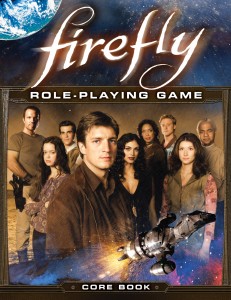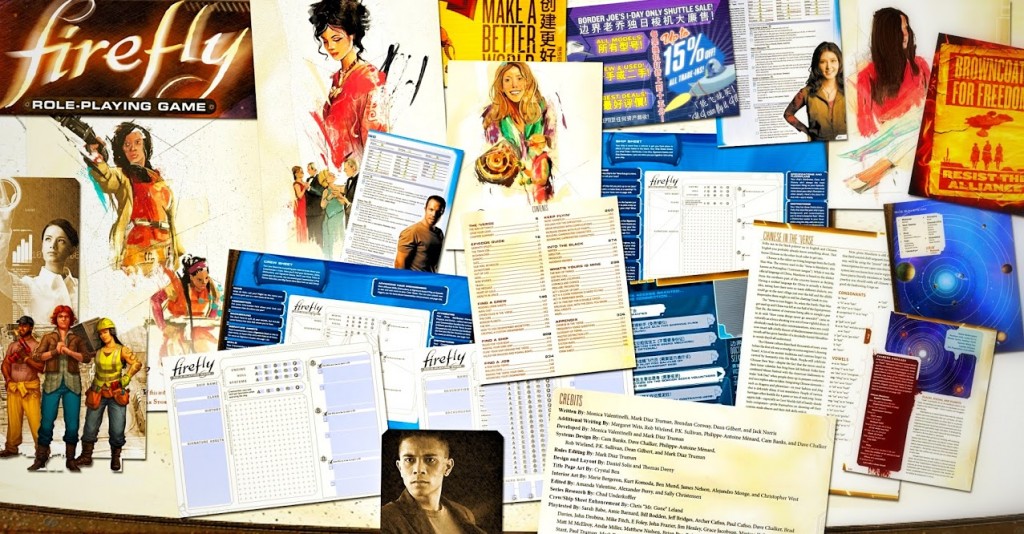
Good morning! There’s lots and lots going on, so I thought I’d pop in and give you an unfiltered brain dump this morning. Mind you, I don’t always like doing this, because I can type faster than I think some days…sad but true. I sometimes think my fingertips are actually sentient, but then I remember all those years of playing and practicing piano while I daydreamed. (I played a lot.) Hee.
I’ve tossed a lot of “Thank you’s” out there, because the Firefly RPG response has been tremendous. It means a lot to me that you’ve talked about the careful attention to detail, the writing, and the game. And, as always, I’m listening and making tweaks to upcoming books based on the response. As a Firefly fan myself, even outside of Margaret Weis’s requests, I wanted to put a game out there that everyone on our team would be proud of. Because of you, my team is excited. It’s a beautiful thing.
That’s how it starts for me. With fans or, rather, the love of characters and story. I got into writing, reading, and drawing, because of the characters I loved as a child — books, comics, movies, games, whatever. (The drawing has since fallen into the abyss. Not enough hours in the day.) ‘Course, there were problems, too… Tons of Star Wars characters, but only one notable heroine to start with: Princess Leia. He-Man, there was the Sorceress who was supposedly uber-powerful, but always had to be rescued. Transformers? Um… And, don’t get me started on the fem-bot from Voltron. Smurfs? Well, there was a token female. Two, if you count what’s-her-face.
It didn’t stop me from watching those shows, playing games, reading voraciously, or writing, though. Instead, it did something else. The lack of representative characterization — which has gotten better over time — made me feel as if I was the cheese that stood apart. Now, I don’t want to talk about all the other factors that contributed to that. (Partly, because I don’t want to be the writer you know because she’s whined about “X”, “Y”, or “Z” in her past, events that have since been resolved. For me, that’d be a cheap trick. If you’ve met me, you know I’m a crappy liar and often “accused” of being genuine. Hah.)
However, I’ve always felt a little defeated by the prevalence of a certain type of character, a certain role women had, a lack of diversity. Gods, this world? Beautiful. So many people, so many cultures, so many stories waiting to be uncovered. I believe different viewpoints make a story better, which is why diversity is so incredibly exciting to me. When I complain? The response is that I’m being too whiny, I’m imagining some fake slight, or I’m given an example of “a” representative character. Or worse, I consciously avoid the rant because someone may be interested in hiring me, and sees me rant online (which I do rarely), and then makes a decision not to because I’m too [insert your word of choice here]. That isn’t an imagined thing, either, people make decisions about other folks all the bloody time; that can’t be controlled. I just don’t want to put a rant out there that gets repurposed five, ten years from now. I am always striving to be a better person, to learn and understand and grow. The internet does not forgive or forget. Remember, writing is my career now and in the future, not my hobby. The only consolation I have, is that apparently my rants are rather tame. Which…is probably true because it’s in writing, as opposed to in person. WAY less swear-y. More rational.
The thing of it is, I am too… Well, too much sometimes. (I get that a lot.) I am a very passionate person, the storm beneath the calm. Emotions? Hand gestures? A deep desire to throw a big damn party and celebrate all the amazing people I’ve met thus far? Yeah, I have all that in spades, and I channel my passion into my work. The bad days are very bad. The good days are very good. And, I’m always striving for balance between the two, because a calm leader is better than a fire-and-brimstone manager. If I want people to be their best, I have to lead by example and be my best to inspire them.
I’d love to not care about the much-ness, and just “be.” In general, I meet people who are interesting, not people who can always give me/provide me with something. In an industry — a very, very, very competitive industry that ebbs and flows, some people do think about networking like adding business cards-with-faces, instead of caring about people. The “p” in publishing, is people. Not paper. Yes, I care about opportunities and meeting people who can help my career and what-have-you, but that’s not me all the time. There’s a time and place to be opportunistic, mind. And, there’s a time and a place to be a human being. I don’t care who I hang with provided we base our conversation on mutual respect or um…entertainment? (Zombie Dice and limericks go great together.) Everybody has a story to tell. I’m always looking for a point of connection, which means I’m not necessarily the best listener. I seek to empathize, to understand, to learn. If someone says, “I feel that Latinas are underrepresented in fiction,” then I’m going to listen and read and ask questions. All of which, incidentally, are then either consciously or subconsciously funneled back into my work. What is art, if not an exploration of our humanity? All seven billion of us?
Either way, after everything… I have learned my lesson well: the fans of today are the professionals of the future. I was a fan, now I’m a professional. (And still a fan.) Everybody — and I mean everybody — should be treated with respect. This is not the same thing as acceptance, however. Acceptance (e.g. bringing someone close to you, into your inner circle) takes time. Jerks do exist, and I feel that they should be dealt appropriately. The good folks? The awesome people? They far outstrip the bad. The good people matter, because those positive experiences, those kind words, they keep me going on the days I want to tell everyone to piss off and give up. I throw everything I have into Firefly, the same way I’ll throw everything I have into all my other projects, because I love my job and my job “pays me” back in ways that go above and beyond the financial. And, I always have more to give. That well doesn’t have a bottom.
But, I feel defeated sometimes and that’s what makes me close up. I walk into a comic book store, and the covers that are presented are all men. I freeze up on my novels (because I don’t write romance) and I feel like I have an impossible road ahead of me. I look at the covers of the action movies out there, and they’re all men. Horror? Lots of female…victims. Great. Write horror? Well, there must be something wrong with me. Obviously. (She says, sarcastically.) And then there’s the other, not-so-subtle ways to feel down: rape/death threats directed at women — sometimes reviewers! — and those fans who think that it happens to men, too, so there can’t possibly be a problem, and we just need to ignore it, and trolls will eventually go away. The idea that popularity is an indicator of quality, when half the time most of us are amazed anyone would read what we put out there (e.g. impostor syndrome), and the other half we’re working on the next project because we have to keep putting food on the table. Yes, these things do happen and, more importantly, I’m sharing this because this is normal — I know I’m not the only one who feels this way.
Some writers and artists give up, and “go” where they feel welcome. How many times have I had that conversation? Others put blinders on, and ignore everything to create what they want, not knowing (hoping) if it’ll take off. There’s always more b.s. in the industry to deal with, even outside of gender, race, etc. issues, because success doesn’t always go to those who deserve or earn it. Luck, or what we perceive to be luck, can happen randomly based on timing alone.
All this, for me, has impacted what I want to do with my original work. I can either play it safe, or I can take risks — by being “me.” Now, if I had more time to philosophize and theorize, I might say something like: “Oh, I guess this is why unconsciously I’ve been playing it safe, to prove that I CAN WRITE to another company’s specifications.”
The reason why I’ve done what I’ve done so far, is really much, much simpler than any high-level esoteric thought processes or any insecurities I might have. (This, too, is epic-normal.) In gaming, there’s larger scale settings like Shadowrun, Pathfinder, the World of Darkness, and Dungeons & Dragons. Outside of the industry, most people know what D&D is, and not necessarily any other. (Though, that continues to evolve.) I haven’t worked on D&D or Pathfinder and, if I did, I’d REALLY screw with the tropes. (Fantasy, urban fantasy, and Lovecraftian horror are three genres I really want to go smash-y, smash-y and play around with.) But, when I say: “I am the lead writer/brand manager for the Firefly RPG.” It’s a point-of-reference outside of the gaming industry, and it’s proof-of-concept. I didn’t just talk about what we wanted to do; we did it. (Talking vs. doing… Worlds apart.)
Now, I’m in the position to focus on my own work, too, to bring that back into the picture. I’ve done a LOT in the background to clear a path for this, too. Some support positions, lots and lots of talking to people, lots and lots of reading, writing, rewriting… Being too careful, really. Being careful not because of fear, but because of feeling defeated, of feeling like I have to do my homework, to prove that I can do solid work — before I take any “risks.” Maybe it’s gender-based. Maybe it’s because I’m “new.” (I will always be new, I swear.) Maybe because I feel self-conscious about the ridiculous number of times people have told me I have an unusual personality. Maybe it’s because I will always feel like I’m catching up. Baggage or not, it is what it is.
Let’s face it, though, any time you or I put original work out there? It is a risk. There’s always the risk a story’ll go unnoticed, or be ignored, or not get paid, or be lied to about royalties, or get plagiarized, or what-have-you. So I’ve come at this the long way ’round, to build a body of work I can do while I work on my original stuff, and I’m there. I’m ready. I pitched a video game, I pitched blind to a comic book company, I’m talking to an artist about my comic, and I’m finally saying: “Yes, this is what I want to do.” As opposed to: “This is what I feel obligated to do. This is what I have to do, because I’m not ready yet.”
Bills? They come every month. They don’t stop, just because I have a desire. So I have to seize the opportunities when they pop up, and keep putting myself out there, not knowing what’s going to happen next. This isn’t the lottery, this isn’t something I do for funsies, this is my [F-bomb’ing] job. If more bills come, then I take a support position, or a retail job, or whatever else it is that I need to do to pay the bills, to keep putting myself out there.
I have no idea what the future holds, and I am not afraid of that. What I am afraid of, though? Is that all my work is invisible — which is different than being invisible. If I wanted to be a celebrity, I would have put myself on that career path. (Make no mistake, being a celebrity is a job, too.) Twitter followers, Facebook likes… All that comes and goes. What I care about? Is that people are reading, playing, and buying my work because they are fans — and I’m a fan, too. I am a fan who’s creating for the fan inside of me, for the fan inside of you.
Do you know what keeps me up at night? Not the bad. Not the great. Not the good. The fear. The fear of my own mortality, that I did not do my utmost best when I was alive and kicking. Always. That? I can’t live with myself if I believe I took a shortcut, if I think I didn’t go that extra mile — not as a martyr, but as a [F-bomb’ing] professional. I always have to try, no matter what. And, in the end, I will always be trying, because if I ever stand up and say I’ve reached the end? That I don’t need to improve? That I’m “good enough” as is? Then there’s no point going any further. Congratulations to me, I have successfully bought my own b.s. and have convinced myself I can stop improving, growing, learning. When that happens? My work will suffer, and I will become insufferable. No more impostor syndrome. Woo-hoo! I’ve made “it.” By whatever imaginary yardstick is out there, I’ve made it. Horrifying. That, too, is unacceptable, because when that happens…well, then I stop being me — and that’s the scariest [F-bomb’ing] thing of all.
- Mood: Deadlines will eat me.
Caffeinated Beverages Consumed: Cries.
Work-Out Minutes Logged Yesterday: Cries some more.
In My Ears: Computer fan.
Game Last Played: Tetris
Book Last Read: Love is the Law by Nick Mamatas
Movie Last Viewed: Captain America: the Winter Soldier.
Latest Artistic Project: National Craft Month
Latest Fiction/Comic Release: Last
Latest Game Release: Firefly RPG corebook
What I’m Working On: Primarily tie-in games work and novels.


